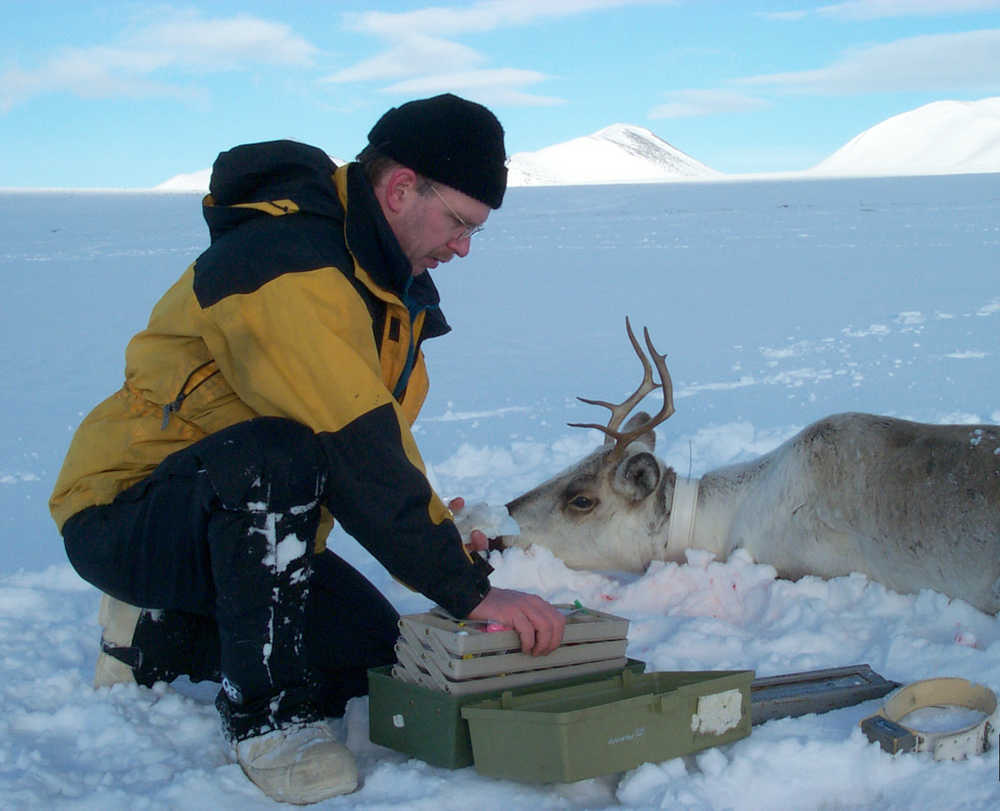Opportunities to view wildlife around our neighborhoods on the Kenai Peninsula are one luxury we often take for granted. Whether it’s a moose in your yard or caribou backing up traffic on Bridge Access Road, large charismatic megafauna are not uncommon sights on the Kenai. These opportunities are not without risk, as most of us know. Collisions with wildlife are always a possibility and we all need to be attentive while driving, especially as daylight dwindles.
In some instances, you may have spotted a moose or caribou along the roadside with a bright orange or white collar hanging around their neck and have asked yourself “why are they wearing such flashy and fashionable attire?” The answer is wildlife management.
Radio collars have been a valuable tool for biologists for over 40 years. Biologists use radio collars to locate animals at different times of the year for a variety of reasons. As technology has progressed, manufacturers have incorporated many useful additions to the old VHF radio collar. One very useful addition has been the inclusion of GPS receivers that log location data at fixed intervals. But a shortcoming of GPS collars is that these data are stored on the collar, meaning the collar must be recovered and downloaded to retrieve the data.
Two years ago, Kenai National Wildlife Refuge biologists fitted moose with GPS collars that also have a satellite phone transmitter incorporated into the collar. This allows GPS positional information from individual animals to be sent directly to a biologist via email, allowing for real time tracking of animals. We use GPS data to track moose movement as it relates to seasonal migration and their behavior around urban centers and roadways on the Kenai Peninsula.
The big question is why we put collars on wildlife in the first place. In the world of ungulates, we typically only put collars on female animals as there are problems when the necks of males expand during the rut. In the case of moose, the Alaska Department of Fish and Game (ADF&G), in collaboration with the Refuge, use radio and GPS collars to track moose movement in Game Management Unit 15. There are currently 50 collared cow moose in GMU 15A, 15 in GMU 15B, and 50 in GMU 15C. We track moose daily during the peak spring calving period to determine if and when calves are born, how many calves they have and, with continued tracking through the year, calf survival and potential causes of mortality.
In the case of caribou, we primarily use collars to assist in finding animal groups to count them during aerial surveys. Last week, ADF&G and Refuge biologists used radio collars to find and count three of the four herds on the Kenai Peninsula — the Kenai Mountain, Killey River and Fox River caribou herds. Knowing herd size allows us to allocate harvest which is reflected in hunting regulations, and to monitor long term population trends. Note that all four caribou herds on the Kenai Peninsula are the result of re-introductions in the 1960s and 1980s.
We estimate the Kenai Mountain herd (KMH) to have 200 caribou. The KMH occupies the Chickaloon River, Big Indian Creek and Resurrection Creek drainages in GMU 7. Their population has peaked out at 400 animals on two occasions (likely limited by their winter range) followed by declines. Population size is currently on the low end and so harvest quotas have been adjusted accordingly. This year, 25 drawing permits are likely to be available through the State drawing permit system and a small number of Federal Subsistence permits in the communities of Cooper Landing and Hope. Our management objectives for this herd are to maintain a post-hunt population of 300 to 400 animals. There are currently 6 radio-collared caribou in this herd with plans to deploy more collars in the spring.
The Killey River herd (KRH), which occupies the mountains between Skilak and Tustumena Glaciers, appears to be doing quite well. Recent aerial surveys indicate the herd to be around 500 caribou. The KRH grew to more than 700 in 2001 before several avalanches killed about 200 caribou. The herd has since grown steadily to current levels. Harvest opportunities are available for KRH caribou through the State drawing permit system. Currently 7 radio collars are deployed in this herd.
The Fox River herd (FRH) is the smallest herd on the Kenai Peninsula and occupies the smallest range, an area south of Tustumena Glacier between upper Fox River and Truuli Creek. The FRH has historically fluctuated between 75-100 animals, and recent aerial surveys indicate 80-90 caribou. Harvest opportunities for FRH caribou are available through the State drawing permit system. Only one radio collar is currently deployed in this herd.
The next time you see a moose or caribou in or around town take a closer look to see if they are wearing a collar. Give them a wave in appreciation of their service if they are. Those collars allow us to better understand the complexities of their lives so we can manage their populations to ensure they will be around for generations to come.
Nathan Olson is the wildlife biologist-pilot at Kenai National Wildlife Refuge. Find more information about the refuge at www.fws.gov/refuge/kenai/ or www.facebook.com/kenainationalwildliferefuge.

